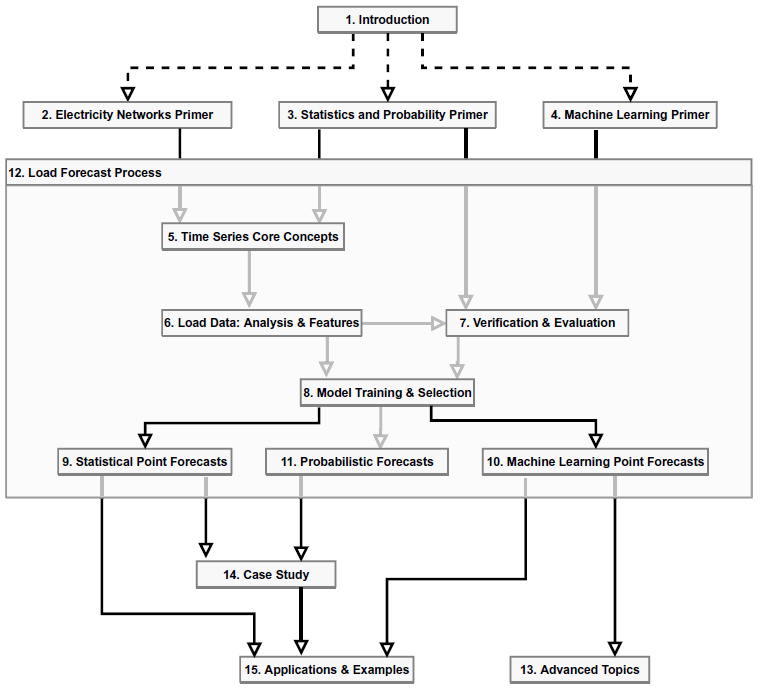Load Forecasting Book Review
- Miha Grabner

- Jun 13, 2023
- Branje traja 6 min
With the growing share of renewable energy and the increasing interest in energy forecasting, the need for comprehensive literature on the subject has become ever more apparent. Unfortunately, outside of scientific papers, such resources are scarce. That is why I am thrilled to share my excitement about an exceptional new book, "Core Concepts and Methods in Load Forecasting (With Applications in Distribution Networks)," authored by Stephen Haben from the University of Oxford, Marcus Voss from TU Berlin, and William Holderbaum from the University of Reading.
This book serves as an invaluable resource, offering a unique and comprehensive overview of the most commonly applied techniques and methods for load forecasting, particularly at the low voltage level.
My decision to review this book was an easy one, as I have had the pleasure of knowing Stephen and Marcus. When such intelligent and talented individuals come together, remarkable things are bound to happen. Thus, my excitement to delve into this book stems not only from their involvement but also from the opportunity to expand my knowledge and gain new insights. Reflecting on my own journey in this field, I am confident that this book would have been an invaluable resource during my early days, making the learning process significantly more manageable.
Stay tuned as I dive into the pages of "Core Concepts and Methods in Load Forecasting," where I will provide you with an in-depth analysis of its contents, its practical applications, and the invaluable knowledge it has to offer.
Why is this book so important?
In the field of energy forecasting, valuable knowledge remains confined to scientific papers, primarily intended for publication by PhD students. Consequently,
a staggering 90% of load forecasting papers end up being useless for practical purposes.
As a newcomer in this domain, it can be challenging to find relevant resources such as work done by Professor Tao Hong and papers discussing the Global Energy Forecasting Competitions (GefCom).
This book will definitely help newcomers and experienced experts because it:
- is FREE and can be downloaded from HERE,
- includes well written case study with Python code in Jupyter Notebook,
- is accompanied with the list of available datasets.
Who should read this book?
This book is an absolute must-read for anyone entering the fascinating world of load forecasting. It accommodates a wide range of audiences, from seasoned experts with a solid background in statistics and machine learning, who can gain valuable insights on the application of their methods in the field of load forecasting, to domain experts such as electrical engineers who seek to grasp the fundamentals and delve into advanced topics of load forecasting modeling. The book combines theoretical foundations with practical implementation, offering a comprehensive exploration of various statistical and machine learning techniques.
Content overview of a book
Let's dive into the content...
In this book, the core concepts of time series forecasting, with a specific focus on low voltage level demand are explored. The reader will gain a solid understanding of fundamental data analytics, delve into effective methods for feature engineering, and explore an extensive array of statistical and machine learning forecast models. To provide practical context, a case study showcases the application of these models to real-world data.
By the time you reach the end of this book, you'll have gained comprehensive knowledge of the entire load forecasting process. Equipped with this expertise, you will be able to develop your own forecasting models.
Additionally, the accompanying figure offers a content overview, illustrating the interconnections and dependencies between various chapters in the book. It serves as a visual guide, enhancing your comprehension and navigation throughout reading.
The book begins by providing a comprehensive introduction to Distribution Electricity Networks, offering readers a brief yet essential overview of the electricity distribution network. This foundational knowledge proves crucial in understanding the network's core features, the corresponding data, key applications, and the process of creating an appropriate forecast model.
Moving forward, Chapters 3, 4, and 5 delve into the theoretical aspects of load forecasting, covering statistics and probability, machine learning, and time series forecasting. These chapters serve as a foundation for constructing accurate forecasts.
I really liked the inclusion of sections titled "How is this translated to short term load forecasts?"
that effectively bridges the gap between theory and practical application.
Chapters 6, 7, and 8 focus on essential aspects such as data preparation and feature engineering, forecast evaluation, and model selection and training, respectively. These chapters address a range of topics, from preprocessing raw data to discussing common features and typical error measures. They prove invaluable, particularly for individuals who lack domain knowledge, as they introduce common practices and facilitate a clear understanding of the field.
The subsequent chapters (9–11) explore point and probabilistic forecast models. Chapter 9 explores traditional time series forecast models like linear regression and ARIMA, Chapter 10 covers methods such as deep learning, random forest, and support vector regression. Chapter 11 introduces probabilistic forecasts, encompassing a blend of statistical and machine learning models. The authors effectively navigate these models, providing insightful discussions and practical applications.
Chapter 12 guides readers through the steps necessary for generating a forecast. It elucidates the main stages involved in developing a forecast model for a specific application and assists in selecting an appropriate model from the plethora of options available.
Chapter 13 delves into advanced topics that have gained popularity in recent scientific literature, including combining forecasts, hierarchical forecasting, household level forecasting, and local and global modeling. Of particular note is the coverage of global modeling, a novel approach with limited available literature in load forecasting (our paper published in IEEE is the first work about using global modeling in load forecasting). I was pleasantly surprised by the authors' inclusion of these topics, as they offer well-described conceptual frameworks.
Chapter 14 serves as a practical demonstration by presenting the implementation of day-ahead load forecasts for residential low voltage networks. It offers an in-depth examination of a case study, complete with Python code examples and Jupyter Notebooks.
The final Chapter 15 focuses on a selected application on battery storage control.
Additionally, the appendix covers a few intriguing topics, such as weather data for energy forecasting. Understanding the basics of numerical weather prediction (NWP) models, differentiating between weather station observations, reanalysis, and forecast data, is crucial for creating models in production.
What is missing?
However, despite the overwhelmingly positive tone of my blog thus far, I feel I have to provide a minor critique :D By doing so, I aim to ensure that my readers do not perceive any bias on my part, given that I know the authors.
So, this is solely my opinion and based on how I develop forecasting models. I have deep understanding in using Multiple Linear Regression models (although the models itself are easy to understand, developing a good model is much harder than using any kind of fancy algorithm, because you need in-depth understanding of the data and modeling itself) and any kind of neural network (I have implemented most of the architectures in the literature).
I think it would be valuable to add description and the code for a following models:
Multiple Linear Regression based benchmark used in GefCom competitions. I have explained this in my blog (there is also a GitHub link to the Python code).
Advanced Multiple Linear Regression model such as this. These kind of approaches have been implemented by many utilities and had also won GefCom. Although the modeling procedure does not work well on European loads, understanding the intuition behind it, help you to develop excellent models.
Multi-layer perpectron developed by EPRI in the late 90'. Although this paper is very old, this model was deployed accross many utilities in the US and modeling approach works very well also on European loads. Or this model from GefCom. Although there are many fany neural networks architectures in the literature, from my experience well designed MLP models in many cases perform better than popular LSTMs or convolutional networks and are also much easier & cheaper to train.
Conclusion
The book provides a comprehensive overview of the field, and I am confident that even if you are already familiar with it, you will still discover new insights and knowledge due to its extensive coverage of various topics. Its structure ensures easy navigation and understanding of the subjects discussed. It is evident that the book was primarily authored by a mathematician who possesses a deep understanding of the field, as the problems are well-formulated, and the theoretical concepts are seamlessly connected to the domain of load forecasting.
Generally speaking congrats to the authors for a remarkable work!









Komentarji